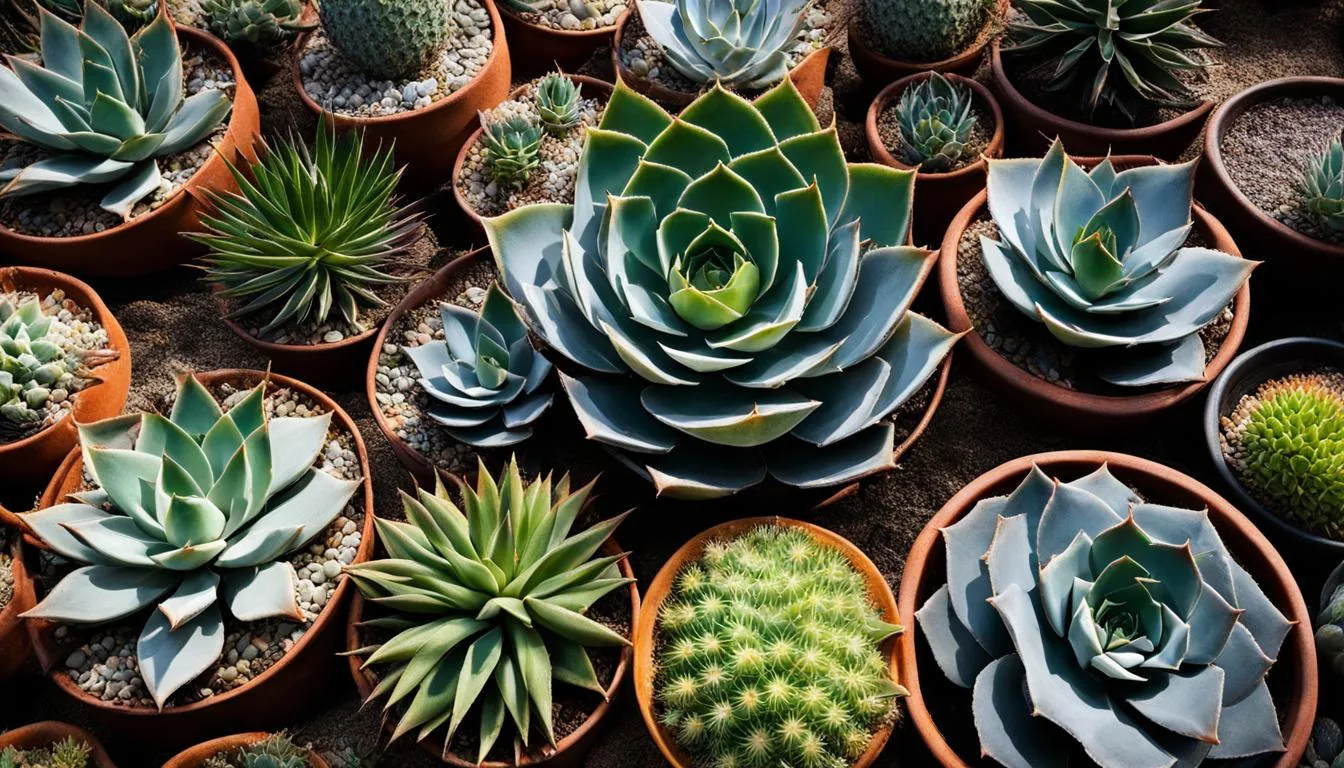
Are you looking to add a touch of elegance to your garden or indoor space? Look no further than agave plants. These stunning, low-maintenance succulents are the perfect choice for those seeking a statement plant that requires minimal care.
With their unique physical appearances and resilience, agaves can thrive in various climates and landscapes. Let me guide you through the essentials of agave care, from cultivation to maintenance.
Key Takeaways:
- Agave plants are popular, low-maintenance succulents known for their drought tolerance and resilience.
- They come in different species with unique physical appearances and growth requirements.
- Agaves can live for 10 to 30 years and produce a massive flower in the center.
- They are native to Western America, Mexico, and parts of South America and the Caribbean Islands.
- Agave plants make excellent ornamental additions to gardens and homes, adding a touch of beauty and sophistication.
The Variety of Agave Succulents
Agave succulents are a diverse group of plants that offer a wide range of colors, shapes, and sizes. Whether you’re looking for a statement plant or a unique addition to your succulent collection, there’s an agave variety for everyone.
Here are some common types of agave succulents:
- Century Plant: With its blue-gray leaves and towering height, the Century Plant is a majestic addition to any landscape.
- Artichoke Agave: Known for its spiky blue or green leaves and yellow flower stalk, the Artichoke Agave adds a touch of drama to gardens.
- Blue Agave: Famous for its use in tequila production, the Blue Agave features striking blue leaves and vibrant yellow flowers.
- Queen Victoria Agave: This smaller agave variety produces cream or reddish-purple flowers and is perfect for smaller spaces.
- Agave Attenuata: Also known as the Lion’s Tail Agave, this variety has soft, curved leaves that give it a unique appearance.
- Agave Snout Weevil: While not a plant variety itself, the Agave Snout Weevil is a common pest that affects agave succulents.
Each agave variety offers its own charm and beauty, making them popular choices for both indoor and outdoor cultivation.
Common Agave Choices
| Agave Variety | Appearance | Flowering |
|---|---|---|
| Century Plant | Blue-gray leaves, tall height | Produces a massive flower in the center |
| Artichoke Agave | Spiky blue or green leaves | Yellow flower stalk |
| Blue Agave | Striking blue leaves | Vibrant yellow flowers |
| Queen Victoria Agave | Smaller size, cream or reddish-purple flowers | – |
| Agave Attenuata | Soft, curved leaves | – |
| Agave Snout Weevil | – | – |
Basic Care Guidelines for Agave
Growing and caring for agave succulents is relatively straightforward, making them an ideal choice for both novice and experienced gardeners. These hardy plants require minimal maintenance and can thrive in various environments. To ensure the health and longevity of your agave, here are some basic care guidelines to follow:
Watering Agave
When it comes to watering agave, it’s important to strike a balance. These succulents are drought-tolerant and do well in arid conditions, but they still require regular watering. It’s recommended to water agave plants every 7 to 10 days, providing 2 to 4 dropper squeezes of water. Be sure to allow the soil to dry out completely between waterings to prevent root rot.
Light and Temperature
Agave plants thrive in bright sunlight, making them ideal for sunny locations both indoors and outdoors. They require at least 6 hours of direct sunlight each day to promote healthy growth.
In terms of temperature, agaves prefer a range between 60 and 90 degrees Fahrenheit (15 to 32 degrees Celsius). They can tolerate lower temperatures but may show signs of stress in extreme cold. If growing agave outdoors, be mindful of frost and provide protection when necessary.
Repotting Agave
As your agave plant grows, you may need to repot it to accommodate its increasing size. Repotting should be done every 2 to 3 years, or when the plant has outgrown its current container.
When repotting, carefully remove the pups (small offsets growing at the base of the mother plant) and plant them in a cacti or succulent potting mix. Ensure the new pot has adequate drainage to prevent waterlogged soil, which can lead to root rot.
| Agave Care Guidelines | |
|---|---|
| Watering | Every 7 to 10 days, 2 to 4 dropper squeezes of water |
| Light | At least 6 hours of direct sunlight per day |
| Temperature | 60 to 90 degrees Fahrenheit (15 to 32 degrees Celsius) |
| Repotting | Every 2 to 3 years, using a cacti or succulent potting mix |
Growing Agave in Different Environments
Agave succulents are incredibly versatile plants that can thrive in various environments, making them a popular choice for gardeners. Whether you have a sandy area, a rocky slope, or even a woodland, there is an agave species that can adapt and flourish. The key to successfully growing agave lies in understanding their specific growth requirements and providing the right conditions for them to thrive.
One of the essential factors in growing agave is the type of soil you use. Agaves prefer sandy soil with good drainage. This helps prevent waterlogging, which can lead to root rot. When planting agave in an outdoor garden, make sure to dig a hole that is twice the size of the plant and fill it with cactus soil or a well-draining succulent mix.
Proper watering is also crucial for the successful growth of agave. These resilient plants are drought-tolerant, meaning they can withstand periods of dryness.
It’s important not to overwater them, as this can cause the roots to rot. During the growing season, water your agave sparingly, allowing the soil to dry out between waterings. In contrast, during the dormant season, reduce watering even further to mimic their natural environment.
Agave Growth Requirements:
- Well-draining sandy soil
- Sparse, infrequent watering
- Full sun to partial shade
- Temperature range between 60 and 90 degrees Fahrenheit
Agaves thrive in full sun to partial shade, so it’s essential to choose a location that receives ample sunlight throughout the day. However, if you live in an extremely hot climate, providing some afternoon shade can help protect the plants from scorching sunburn.
To summarize, growing agave in different environments requires specific attention to their growth requirements. These resilient succulents prefer sandy, well-draining soil, sparse watering, and plenty of sunlight. By providing the right conditions, you can enjoy the beauty and resilience of these statement plants in your garden or home.
Tips and Tricks for Agave Care
When it comes to caring for agave plants, there are a few tips and tricks that can help ensure their health and longevity. Here are some key factors to consider:
Agave Soil Mix
One important aspect of agave care is the soil mix. Agaves thrive in well-draining soil, so it’s important to use a mix that allows excess water to flow freely. A recommended soil mix for agave plants is a combination of cactus soil and perlite, which helps improve drainage and prevent overwatering.
Agave Light Requirements
Another crucial element of agave care is providing adequate sunlight. Agave plants require plenty of sunlight to thrive, so it’s best to place them in a location that receives full sun for a significant part of the day. Whether indoors or outdoors, agaves need at least 6 hours of direct sunlight daily to maintain their health and vibrant colors.
Protecting Agave from Pests
Like any other plants, agaves can be prone to pests. One common pest that can affect agave plants is the agave snout weevil. To protect your agave from these pests, it’s important to regularly inspect your plants for signs of infestation, such as holes in the leaves or wilting.
If you notice any signs of pest activity, it’s best to take immediate action by applying appropriate insecticides or seeking professional assistance.
Warm Climate for Agave
Lastly, it’s essential to consider the climate when caring for agave plants. Agaves are best suited for warm climates, as they are native to desert regions. They thrive in temperatures between 60 and 90 degrees Fahrenheit (15-32 degrees Celsius).
If you live in a colder climate, it’s important to protect your agaves from frost and provide them with adequate warmth, such as by moving them indoors during the winter months or covering them with blankets or frost cloths.
By following these simple tips and tricks for agave care, you can ensure your plants stay healthy and vibrant for years to come. Remember to provide a well-draining soil mix, ample sunlight, protect them from pests, and create a warm environment to help your agaves thrive.
Agave as a Must-Have Statement Plant
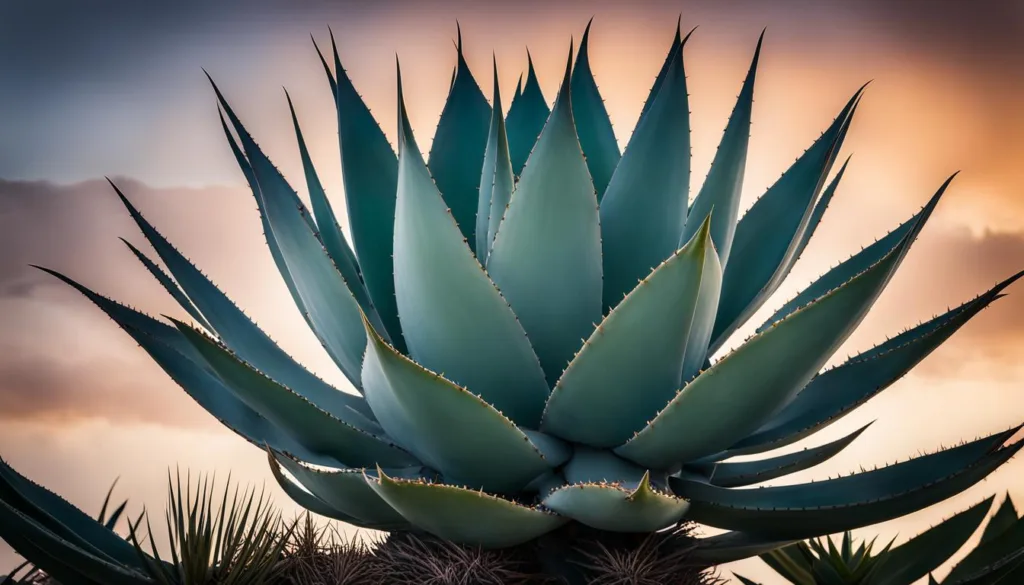
If you’re looking to make a statement with your plant choices, look no further than agave succulents. These stunning plants are not only visually striking but also incredibly long-lasting. With proper care, agave plants can live for several decades, making them a worthwhile addition to any garden or indoor space.
One of the key attractions of agave plants is their unique colors. From vibrant greens to bold blues and even shades of purple, agaves offer a wide range of hues to choose from. These colors can add a pop of visual interest to any space, creating a focal point that commands attention.
When it comes to growing conditions, agave plants are relatively low-maintenance. They require minimal watering and can tolerate a variety of climates, making them suitable for both indoor and outdoor cultivation.
Whether you’re a seasoned gardener or just starting out, agave plants are a great choice for those looking to add a touch of elegance and sophistication to their surroundings.
Agave Longevity and Resilience
One of the standout features of agave plants is their impressive longevity. With proper care, these plants can thrive for many years, bringing beauty and character to your space.
Agaves are known for their resilience, able to withstand harsh conditions and continue growing. This makes them a reliable choice for those looking for a plant that can stand the test of time.
| Feature | Agave Plants |
|---|---|
| Longevity | Several decades |
| Colors | Wide range, including greens, blues, and purples |
| Growing Conditions | Low-maintenance, minimal watering required, can tolerate various climates |
Agave in Desert Gardens
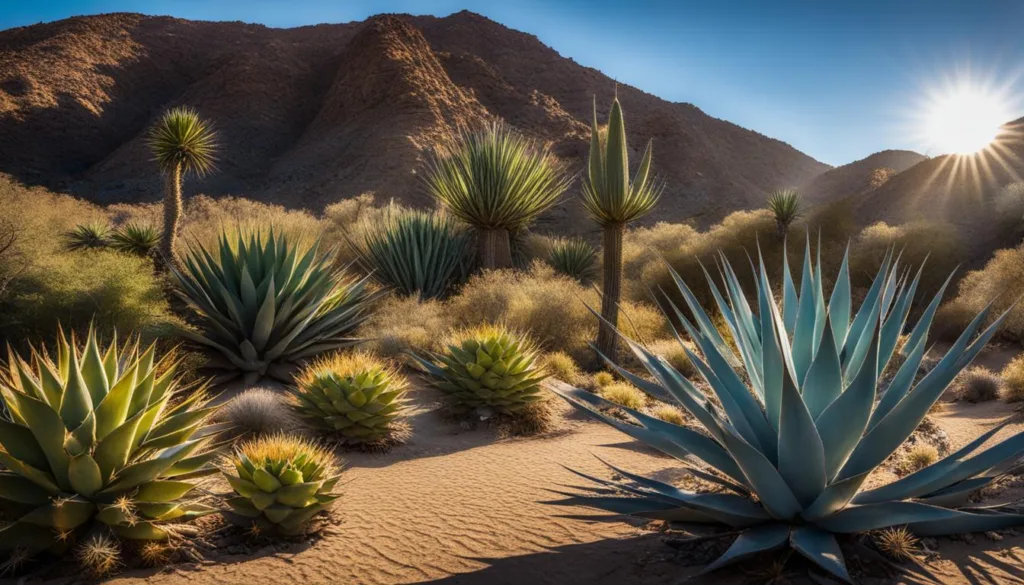
Growing agave plants in desert gardens can be a stunning addition to the landscape. These succulents are native to desert areas and are well-suited to the harsh conditions found in these environments. However, it is important to provide some shade to protect the agave plants from the direct desert sun.
The deep root system of agave plants allows them to search for water even in arid conditions. When planting agave in desert gardens, it is crucial to provide sandy soil with excellent drainage.
This helps prevent waterlogging and root rot, which can be detrimental to the plant’s health. Place the crown of the plant above the soil line to avoid crown rot, a common issue in agave cultivation.
Agave planting tips for desert gardens include selecting the right variety of agave for your climate and considering the overall design of your landscape. Ensure that the agave has enough space to grow and spread its foliage, as some varieties can reach impressive sizes.
With proper care and attention to the unique requirements of desert gardening, agave plants can thrive and become a focal point in your garden.
Agave in the Desert Sun
When growing agave in desert gardens, it is important to protect the plants from the intense desert sun. While agaves are drought-tolerant and can handle high temperatures, prolonged exposure to direct sunlight can cause sunburn and damage the plant’s leaves. Providing partial shade, especially during the hottest parts of the day, can help protect the agave plants and keep them healthy.
| Agave Variety | Growth Height | Leaf Color |
|---|---|---|
| Century Plant | Up to 15 feet | Blue-gray |
| Artichoke Agave | 3-4 feet | Blue or green |
| Blue Agave | 4-6 feet | Blue-green |
| Queen Victoria Agave | 1-2 feet | Green |
Agave Planting Tips
When planting agave in desert gardens, follow these tips for successful growth:
- Choose a sunny location with partial shade.
- Ensure the soil has excellent drainage, using sandy soil mixed with gravel or pumice.
- Plant the agave with the crown above the soil line to prevent crown rot.
- Space the agave plants adequately, considering their mature size.
- Water sparingly, allowing the soil to dry out between waterings.
Maintaining Your Agave Plants
Proper maintenance is key to keeping your agave plants healthy and thriving. With a few simple guidelines, you can ensure that your statement plants continue to make a bold statement in your garden or home. Here’s what you need to know about agave plant maintenance:
Agave Watering Schedule
Agave plants are highly drought-tolerant and do not require frequent watering. In fact, overwatering can cause root rot and other issues. It is best to water your agave sparingly, allowing the soil to dry out completely between waterings.
For the first month after planting, water your agave every 4-5 days. Once established, decrease the frequency to 2-3 times a month, especially during the summer when the plant is actively growing.
Agave Feeding
Agave plants do not require regular fertilization, as they are naturally adapted to nutrient-poor soils. However, feeding your agave during the growing season can promote healthier growth and vibrant colors. Use a specialized plant food formulated for succulents, such as liquid succulent plant food. Follow the instructions on the packaging for application rates and frequency.
Recommended Products for Agave Care
When it comes to caring for your agave plants, choosing the right products can make a significant difference. Here are some recommended products for agave care:
| Product | Usage |
|---|---|
| Moisture Control Potting Mix | Provides well-draining soil for agave plants |
| Garden Soil for Vegetables and Herbs | Can be mixed with cactus soil for outdoor planting |
| Tomato, Fruit & Vegetable Plant Food | Provides essential nutrients for agave plants |
Using these recommended products can help ensure that your agave plants receive the right nutrients and have optimal growing conditions.
By following a proper watering schedule, feeding your agave when needed, and using the right care products, you can maintain the health and beauty of your statement plants. With their resilience and striking appearance, agave plants will continue to make a bold statement in your garden or home for years to come.
Easy Agave Growing Tips: Enhance Your Garden with Vibrant Colors
When it comes to growing agave plants, there are some easy tips and recommendations that can help you create a vibrant and successful garden. Whether you are a beginner or an experienced gardener, these agave growth tips will ensure that your plants thrive and add beauty to your outdoor space.
Choosing the Right Agave Varieties
One of the key factors in easy agave growing is selecting the right varieties for your garden. There are numerous agave species available, each offering unique colors and growth patterns.
Some popular choices include the Blue Agave, which displays stunning blue-gray leaves, and the Queen Victoria Agave, known for its smaller size and cream or reddish-purple flowers.
By choosing the varieties that best suit your climate and aesthetic preferences, you can ensure a successful and visually appealing garden.
Providing Adequate Watering and Sunlight
Agave plants are well-adapted to dry environments and require minimal watering. To facilitate easy agave growing, it’s important to strike the right balance between providing enough moisture for the plants without overwatering them.
Water your agaves sparingly, allowing the soil to dry out between waterings. Additionally, agave plants thrive in full sun or bright, indirect light. Ensure that your agaves receive adequate sunlight throughout the day to promote healthy growth and vibrant colors.
Creating a Well-Draining Soil Mix
Another crucial aspect of easy agave growing is creating a well-draining soil mix. Agave plants prefer sandy soil with good drainage to prevent root rot and other moisture-related issues.
Mix sand or gravel into your soil composition to improve drainage. If you are growing agaves in containers, choose a cactus or succulent potting mix designed for excellent drainage.
By providing the right soil conditions, you can prevent waterlogged roots and support the overall health of your agave plants.
| Agave Growth Tips | Agave Colors | Agave Watering Recommendations |
|---|---|---|
| Choose the right agave varieties for your garden | Blue-gray, cream, reddish-purple | Water sparingly, allow soil to dry out between waterings |
| Provide adequate sunlight | Vibrant shades of green, blue, and purple | Full sun or bright, indirect light |
| Create a well-draining soil mix | Ranging from pale green to deep burgundy | Use sandy soil with good drainage |
By following these easy agave growing tips, you can create a stunning garden filled with vibrant colors and unique foliage. Whether you are a novice gardener or an experienced plant enthusiast, agave plants offer a low-maintenance and visually rewarding addition to any outdoor space. Give your garden a touch of elegance and style with these versatile and resilient succulents.
Agave as a Versatile Landscape Addition
Agave plants are not only beautiful statement plants but also versatile additions to any landscape design. Their unique architectural structure and stunning colors make them visually appealing and can enhance the overall aesthetic of your outdoor space.
Whether you are creating a modern, minimalist garden or a vibrant, tropical oasis, agave plants can be incorporated seamlessly into various themes and styles.
One of the advantages of using agave in landscape design is their versatility. They can be used as stand-alone specimens to create a bold focal point or combined with other succulents to form a visually stunning arrangement.
Agave’s striking appearance and contrasting textures make them perfect for creating eye-catching compositions. You can experiment with different combinations of agave varieties to achieve a harmonious blend of colors and forms.
When designing your landscape with agave, consider the size and growth habits of the different varieties. Some agave plants can grow quite large, while others remain more compact.
By strategically placing the larger varieties in the background and the smaller ones in the foreground, you can create depth and dimension in your garden. Additionally, grouping agave plants of the same variety together can create a cohesive and cohesive look.
Another way to incorporate agave into your landscape design is by using them as border plants or in rock gardens. Their spiky leaves and rigid structure add an element of texture and interest to these areas.
You can also plant agave in containers and place them strategically around your outdoor space to create focal points or to highlight specific areas.
Agave Combinations with Other Succulents
| Agave Variety | Complementary Succulents |
|---|---|
| Blue Agave | Aloe Vera, Echeveria, Sedum |
| Queen Victoria Agave | Kalanchoe, Senecio, Graptopetalum |
| Artichoke Agave | Agave Parryi, Agave victoriae-reginae, Agave desmetiana |
| Century Plant | Yucca, Opuntia, Dasylirion |
When combining agave with other succulents, consider factors such as their water and light requirements, as well as their growth rate. It’s important to select succulents that have similar care needs to ensure they thrive together. By carefully choosing the right combination of agave and other succulents, you can create a visually stunning and cohesive landscape design.
Overall, agave plants offer endless possibilities for landscape design. Their versatility, unique beauty, and low-maintenance nature make them a popular choice among gardeners and landscapers.
Whether you want to create a desert-themed garden, a modern minimalist space, or a lush tropical paradise, agave plants can be the perfect addition to bring your vision to life.
Agave as an Iconic Succulent Plant
Agave plants have become iconic succulents in the plant world, admired for their unique and striking appearance. With their bold shapes and vibrant colors, agave succulents have gained popularity among plant enthusiasts and are often chosen as statement plants. Whether grown indoors or outdoors, agave plants make a stunning addition to any space.
One of the reasons why agave is regarded as such a popular succulent is its ability to thrive in various growing conditions. Agave plants can withstand harsh climates and are known for their resilience. With minimal maintenance and care, they can live for many years, making them a long-lasting and iconic choice for plant lovers.
Growing agave for an iconic display requires providing the right conditions. Agave succulents prefer well-draining soil and are best suited for warm environments.
They thrive in full sunlight, making them ideal for gardens and outdoor landscapes. With their distinctive foliage and striking presence, agave plants can become the focal point of any space, creating a visually stunning and iconic display.
Benefits of Growing Agave as an Iconic Succulent Plant:
- Unique and striking appearance
- Long-lasting and resilient
- Thrives in various growing conditions
- Low maintenance and care
- Creates a visually stunning focal point
| Agave Varieties | Appearance | Flowering Pattern |
|---|---|---|
| Century Plant | Blue-gray leaves | Massive flower stalk after several years |
| Artichoke Agave | Blue or green leaves with sharp spines | Yellow flower stalk |
| Blue Agave | Blue-green leaves | Vibrant yellow flowers |
| Queen Victoria Agave | Smaller size with cream or reddish-purple flowers |
After exploring the world of agave care, it is clear that these statement plants are a fantastic addition to any garden or home. With their unique colors, textures, and architectural structure, agave succulents provide a stunning display that will surely capture attention.
The best part is that growing agave is relatively easy, as they are low-maintenance plants that require minimal watering and thrive in various environments.
To summarize the key points of agave care, it is important to provide them with sandy soil and good drainage, whether planting them in an outdoor garden or in a pot indoors.
Water sparingly and ensure they receive ample sunlight to promote healthy growth. Protect them from pests and choose a warm climate for optimal results.
With these simple care guidelines and a little bit of attention, you can successfully cultivate agave plants and enjoy their beauty for many years to come.
So why not add these iconic succulents to your garden or indoor collection? Agaves are sure to become a focal point and create a striking statement in any space.
FAQ
How often should I water my agave succulents?
Agave succulents should be watered every 7 to 10 days, with 2 to 4 dropper squeezes of water.
What temperature range do agave plants thrive in?
Agave plants thrive in temperatures between 60 and 90 degrees Fahrenheit.
How do I repot agave plants?
When repotting agave plants, the pups should be separated from the mother plant and placed in a cacti or succulent potting mix.
Where do agave succulents grow best?
Agave succulents can grow in various environments, including cliffs, woodlands, sandy areas, beaches, riparian areas, and rocky slopes.
How should I care for agave in a desert garden?
Agave plants in desert gardens should be placed in partial shade to protect them from direct desert sun.
How often should I water agave plants in a desert garden?
Agave plants in desert gardens should be watered every 4-5 days for the first month and then 2-3 times a month in summer.
What should I feed my agave plants?
Feeding with a specialized plant food, such as liquid succulent plant food, can be done during the growing season.
How long do agave plants live?
Agave plants can live for 10 to 30 years.
Can agave plants be grown indoors?
Yes, agave plants can be grown indoors near a window or outdoors in direct sunlight.
What are some tips for caring for agave?
Some tips for caring for agave include mixing the soil with sand, providing ample sunlight, protecting the plants from pests, and ensuring they are in a warm climate.

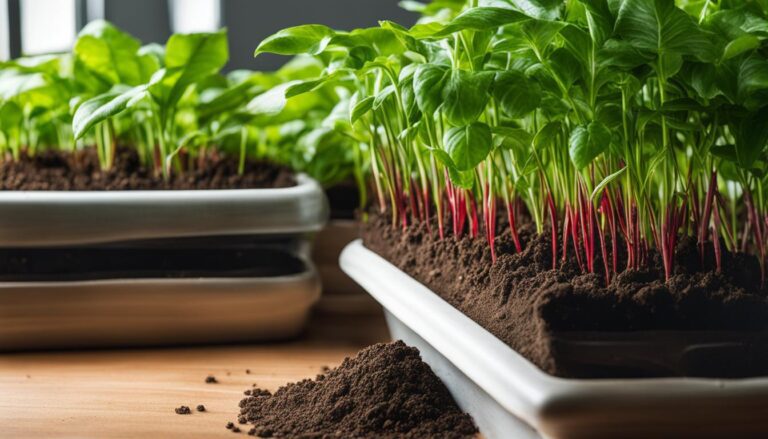
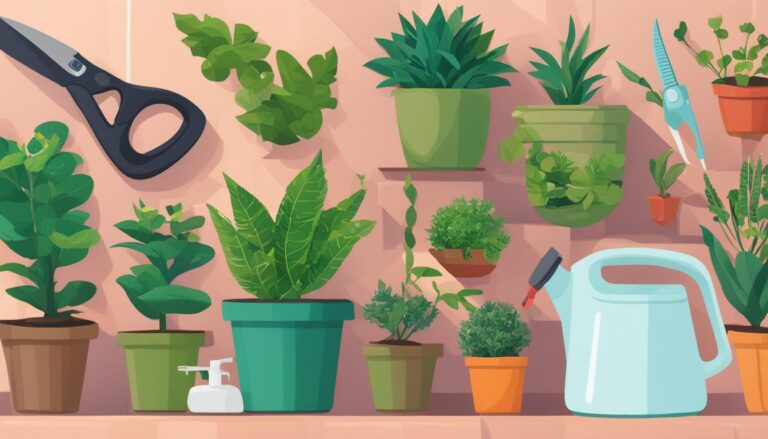
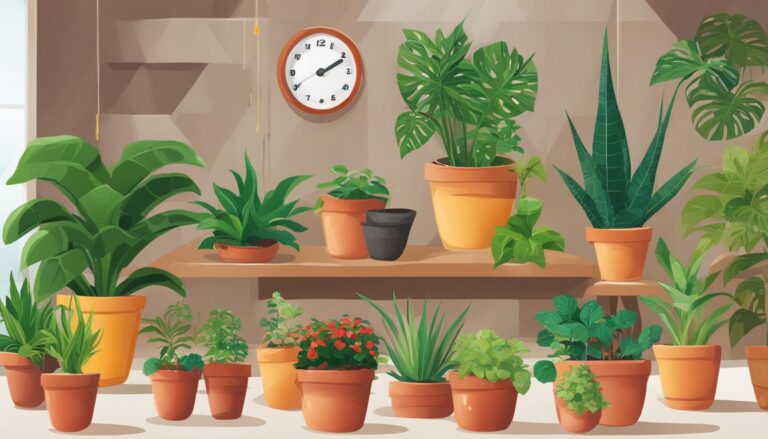
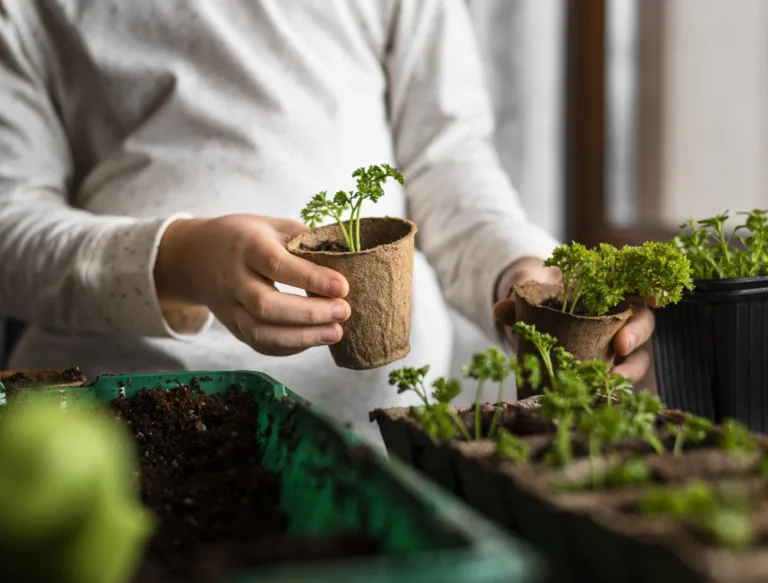
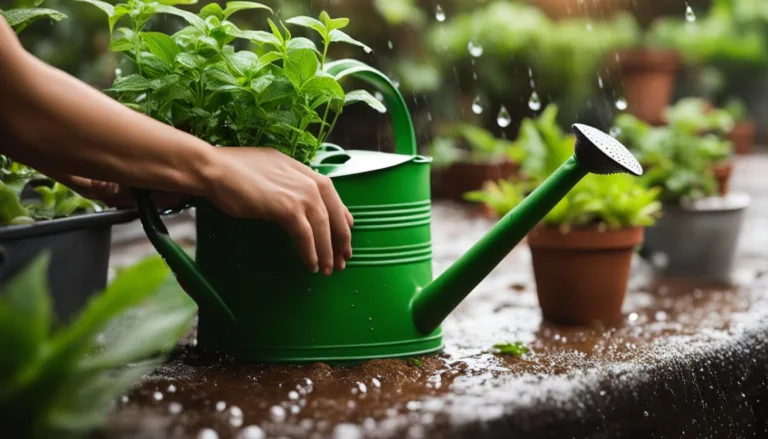
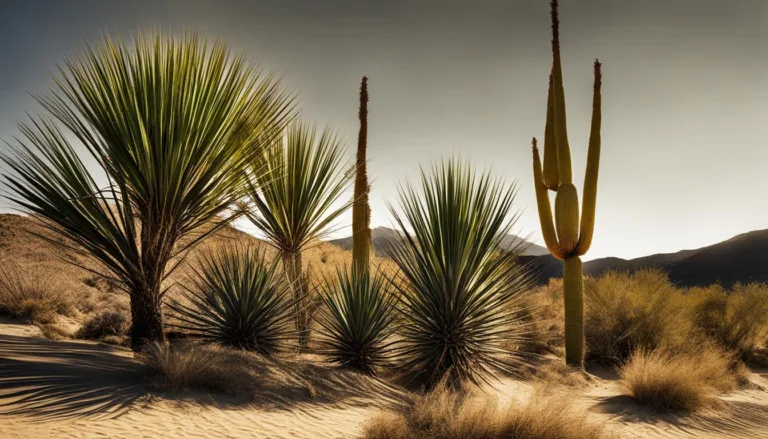
2 Comments
Comments are closed.